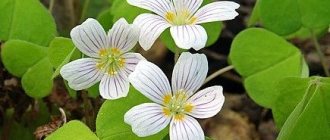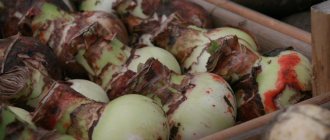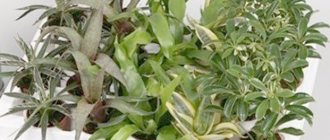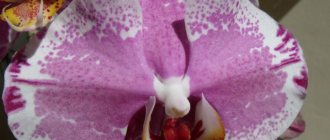What kind of plant is this?
Botanical description
Rose mix belongs to the Rosaceae or Rosehip family . This variety was bred by breeders specifically for growing at home.
Peculiarities
The plant is a small shrub up to 65 centimeters high.
The size and color of the buds depend on the type of flower. As a rule, this is a miniature rose endowed with a delicate aroma. This variety of roses can bloom several times a year. At the same time, the flowers on the plant retain their color and aroma for a long time.
Basic rules of care and maintenance features
How to care for mixed roses after purchase so that the plant pleases with abundant flowering? These flowers are quite capricious. Without proper care, they will not delight with lush flowering, in addition, the bushes may die. When purchasing this type of prickly beauty, it is important to adhere to the recommendations of specialists regarding care.
Watering
Rose Cordana mix: can it be planted in open ground?
The plant needs systematic soil moisture. For irrigation you need to use clean water at room temperature.
Important! Bush rose mix requires abundant, but not frequent watering. Otherwise, the root system may begin to rot. In the hot months, the bushes need to moisten the soil twice a day. As the heat subsides, the frequency of watering decreases. Positive growth dynamics are observed when combining spraying of bushes and moistening the soil.
In the cold season, you can only spray the bushes. It is very important that during the active growth period the plant receives sufficient light and moisture.
Lighting
Roses of the Mini Mix variety, especially such as Danica Premium, Monde, Favorite Mix, Palace, are in dire need of constant lighting. Special lamps can be used for this. If you can’t buy them, you can achieve the desired result using a regular fluorescent lamp. If the grower provides the plant with constant lighting, the flowering of the bushes will last almost continuously. Caring for Star Roses at home is not difficult, but consistency is very important.
Transfer
After purchasing a plant in a pot, it is important to urgently transplant it into another container. Transplantation can be carried out at any time of the year. However, the best time for transplantation will be mid-April or the end of August. To replant, you will need to purchase special soil designed for growing indoor roses. The soil should have a loose structure and be slightly moist. Recommendations that experts advise to follow when replanting bushes:
- the thickness of the drainage layer should be within 1 cm;
- It is best to plant a plant during the period when the Moon is waxing;
- during replanting, it is worth placing a plant in another pot, the root system of which retains the layer of the previous soil;
- after planting is completed, the foliage of the bushes is sprayed;
- the plant should be moistened only 24 hours after planting in a new pot. Water should be used at room temperature.
Pruning and replanting roses
Subvarieties and their photos
Parade
Low plant (40 – 45 cm). Pleases with lush flowering for 5 - 6 months. Then follows a two-month break. Best adapted to home conditions.
Patio hit
The rose belongs to the floribunda group . The stem length is 50 – 55 cm. Large flowers can be of different shades, they even have two-color petals. Blooms long and profusely.
Mini
Dwarf plants (up to 40 cm). The buds can be either small or large in size.
Danica
A small plant about 30 cm high. The size of the petals in a bud is approximately 3 - 5 cm. Their color may vary.
You may be interested in learning about other types of indoor roses, namely the Cordana variety and bush roses.
Description and characteristics
A miniature rose can be only 28-30 cm tall or reach a height of 50 cm. The variety of shades allows everyone to choose a flower to their liking.
The abundant flowering of rose mix does not stop throughout the season. The plant looks amazing both along the path and in the flowerbed. If the bushes are provided with good shelter, they will be able to withstand even severe frosts.
Flower varieties are not selected for sale, hence the name roses received. Although belonging to a certain variety is clearly visible. In some cases, there may be some differences in the characteristics of plant varieties when comparing specimens obtained by cuttings and bred by selective breeding.
Rosa Mix
By following the recommendations of experts, you can grow miniature roses on your own plot and enjoy their beautiful blooms every year.
How to grow an indoor flower in a pot?
Landing
Growing a mixed rose from seeds is a complex and time-consuming task . Under natural conditions, seeds are kept in the ground at a certain temperature throughout the winter, which promotes accelerated germination. Similar conditions must be created at home. What is needed for this?
- A material capable of retaining moisture (cloth napkin, cotton pad, etc.) must be soaked in a solution of hydrogen peroxide, rose seeds placed on it, and covered with a layer of the same material.
- In this form, the seeds are placed in a plastic container or plastic bag and sent to the lower compartment of the refrigerator for 2 months. During this time, you need to monitor their condition and, if necessary, moisturize the surrounding matter.
- Sprouted rose seeds are planted in seedling pots. The room temperature should be approximately 18-20 °C. Sprouts need good lighting for 10 hours.
Watering should be moderate. Excess moisture can lead to the death of the plant. In order for the root system to develop sufficiently, the first buds should be cut off.
How to care?
Rose mix requires constant monitoring and control. Ignorance and failure to follow the rules of care can lead to illness and death of the plant.
Conditions of detention:
- Place . This rose will be comfortable on any windowsill, except the northern one. The east side is best. The plant should be protected from direct sunlight. If the window is facing south, on a sunny day you need to close the blinds or create a protective screen.
- Temperature . In the summer, the most comfortable temperature for rose mix will be 18 – 23 °C. In winter, the flower should be moved to a cooler place (8 - 13 ° C). Too cold air leads to disease of the root system.
- Humidity . For normal growth of rose mix, the air in the room must be high or moderate humidity. During the heating season, the plant should be regularly sprayed with warm water. Once a week it is useful to give your pet a shower. The soil should be covered with polyethylene.
- Lighting . Rose loves long-lasting bright diffused light, BUT NOT DIRECT SUN RAYS.
- Watering . In summer, the flower is watered moderately 2 times a day - morning and evening. In winter, during the dormant period, the frequency of watering is reduced to once every two days in small portions. The water must first be settled. At the time of watering it should be at room temperature. The soil should not be allowed to dry out. But too wet soil can oxidize.
- Feeding .
In the spring, before active flowering, the plant needs to be fed 4–5 times. No longer recommended. Excess fertilizer stimulates active leaf growth. The number of colors decreases. It is better to apply complex fertilizers for flowering plants. You can also alternate phosphorus, potassium and nitrogen fertilizers. In the fall, after flowering, the soil is saturated with saltpeter and superphosphate. Fertilizers should be applied strictly according to the instructions offered by the manufacturers. - Trimming . Yellowed and dried leaves are removed regularly. Old stems and wilted buds should also be cut off as they appear. At the end of the growing season in the fall, mandatory pruning is carried out. The stems are shortened to 10 cm. 3–5 buds are left on the branches. This procedure not only shapes the bush, but also promotes early and lush flowering.
Transfer
A rose mix is transplanted in two cases:
- If the plant is new, it just arrived from the store.
- If the roots have completely filled the container and need to be replanted into a larger pot.
The new plant is not replanted immediately . He needs several days to get used to the new conditions.
- Choosing a pot. Its diameter should be 2-4 cm larger than before, and its height should be 5-7 cm. There must be a drain hole at the base.
- Priming. You can buy it ready-made in the store, or prepare it yourself. It should consist of 1 part sand, 4 parts humus, 4 parts turf with the addition of complex fertilizer.
- A layer of expanded clay 1 cm thick is laid on the bottom of the pot. Next, a layer of earth is poured. It is recommended to add moss and fertilizer.
- Before transplanting, the rose is shed generously with water. When the earthen ball is well wet, it is removed from the pot and replanted. There is no need to shake the roots.
- The plant in the new place is covered with soil. The soil is compacted. No additional watering is required. It is enough to spray the foliage with water from a spray bottle. After a day, the rose needs to be watered.
Prevention from pests and diseases
To prevent the rose mix from being infected by pests and diseases, it must be regularly sprayed, rinsed with a shower and maintained at optimal air humidity in the room.
Reproduction
Mixed roses are propagated in two ways: by stem cuttings in the spring and by pruned branches in the fall. Cuttings intended for planting should be no more than 15 cm and have 3–4 living buds. They are placed in a container with water. When roots appear on the cuttings, they are planted in the ground .
What to do after purchase
Usually Mix roses are sold in 3-4 bushes , planted in small plastic cups, and are only 2-4 months from the moment of rooting. Transparent cellophane packaging protects the flower from damage during transportation, but if the plant is purchased in cold weather or transported over a long distance, it should additionally be wrapped in paper or a plastic bag.
Upon arrival home, a difficult period of adaptation , and the gardener needs to be prepared for this. The plant is weakened by transportation and can shed all its leaves, but after a month it begins to grow again and blooms. For the first two weeks, you can let the rose get used to the new conditions, regularly water and spray it, keeping an eye on moderate soil moisture.
Then it will be transplanted into a new pot with a drainage hole , preferably ceramic with a glazed surface, somewhat larger in width and height, since the cramped container and peat substrate in which the rose was sold are not suitable for further growing a healthy plant. Drainage (vermiculite, expanded clay, brick chips, small pebbles) is poured onto the bottom of the pot to a height of 2–3 cm and the plant is carefully placed into it using the transfer method, i.e. along with a lump of earth and roots, and the remaining cavities are filled with fresh specialized soil for roses.
If a rose does not have flowers or buds before transplantation, this allows it to devote all its efforts to adaptation and increased growth. Otherwise, it is advisable to cut off the flowers and buds, since the flowering period weakens the plant.
fungicides - to the pot with a rose , spray with warm water and place in a shaded place for several days.
Diseases and pests
Most often, the mixed rose is affected by spider mites and powdery mildew.
- Spider mite .
Appears due to insufficient humidity. For prevention, the plant should be regularly sprayed and bathed in the shower. Small bugs of red, red or dark brown color occupy the lower part of the leaves, gnaw holes in them, and entwine the shoots with a thin web. As a result, young shoots dry out and fall off the plant. To combat spider mites, you should use special preparations offered in stores. You can also use folk remedies (garlic infusion or tobacco infusion). - Powdery mildew - white coating on leaves and buds . If urgent measures are not taken, it can cause the death of the plant. How to treat? Trim off all affected areas. Remove the top layer of soil. Adjust the watering schedule so that there is no excess moisture. Spray the bush with a 1% solution of Bordeaux mixture or a 0.4% solution of copper oxychloride. For severe infestations, a fungicide should be used.
How to choose a rose Mix
Moving from a warm, humid greenhouse to the less favorable conditions of a store can cause roses to experience stress that can cause them to lose buds, quickly wilt, and dry out. When purchasing a plant, it will be useful to consider several recommendations:
- Contact specialized greenhouses, trusted stores and departments where professional attention is paid to the transportation and maintenance of flowers.
- Buy a rose in February-March , then acclimatization will be easier.
- Study the appearance of the proposed plant: the earthen ball should be dense, filled with roots; it is desirable to have fresh young shoots (if they are a bit dry, no problem); no limp or spotted leaves or drooping buds; the reverse side of the leaves is pest-free; the bark is fresh and smooth.
Errors in care
- Dry air can cause leaves to dry out, buds to fall off, and shoots to change color. Proper regular watering, spraying, showering will help.
- Pests . They damage the shoots and root system, the plant loses its leaves and stops blooming. Treatment with special preparations and bathing of stems and bushes will help.
With proper care, an indoor mixed rose can delight its owners with abundant and long-lasting flowering all year round. Knowing the basic requirements for the maintenance of this plant, achieving such a result is not very difficult.
Problems during cultivation, causes and solutions
In the process of maintaining an indoor miniature rose, gardeners encounter difficulties, often leading to damage, disease and even loss of the plant.
| Problems | Causes | Solutions |
| The rose does not bloom, although it looks healthy | The presence of “blind”, non-developing shoots | Trimming to 5-6 leaves and treatment with any biostimulant for rose flowering |
| Soil acidification | Pot too big, lack of drainage | Choose a pot of the appropriate size, i.e. 2–3 cm more than the root system, add drainage to the bottom of the pot |
| Leaves and buds dry out | The soil is overdried | Provide urgent watering and spraying, after which the plant can be covered with a bag or jar |
| The leaves are turning yellow | Too frequent watering or lack of fertilizers (potassium, magnesium, nitrogen, iron, etc.) | Take a break from watering, inspect the roots, remove rotten ones; feed with special complex fertilizers for roses or transplant into more nutritious soil |
| Leaves and flowers fade | The rose stands in a draft, watered with cold water | Choose a more comfortable place, water at room temperature |
| Black spots on leaves | Black spot is a fungus of damp, warm atmosphere around a rose, when plants are crowded and there is an excess of nitrogen fertilizers | Spreads from the lower leaves to the top of the crown; the plant will need to be thinned by removing blackened leaves and spraying with fungicides |
| Darkening of shoots | Infectious burn of roses - develops during wintering under cover in conditions of high humidity and poor ventilation | Trim damaged areas and treat the plant with copper sulfate. |
Basic information about the variety
Cordana rose mix: how to care for it after purchase, watering features, photo
The height of the Cordana rose is no more than thirty centimeters. Its distinctive feature is lush and dense greenery and a large number of small buds of the usual shape. The leaves have a rich emerald color. There are different colors of the flower: white, pink, red, yellow. Rose blooms will bring joy throughout the warm season - from May to October.
It is noteworthy that this type of rose does not emit any fragrance at all. The fact, of course, is not very happy, but people are not at risk of allergies from it. Such a rose can be given as a gift without any risk, and indoors it will not cause harm to health.
Cordana rose height
Caring for indoor roses
Light mode
Hibiscus, or Chinese rose: how to care for the plant
House roses are light-loving plants. The best windows are southeast and west. It is too hot for roses on southern windows in the summer; on very sunny days, their flowers open quickly, but quickly fade. It's too dark on the northern windows. If in the summer indoor roses are taken out into the garden and placed directly in pots on the leeward side, then they easily get used to a sunny place, but may get slightly tanned (the petioles and leaves acquire a reddish tint).
Fresh air
Roses are very demanding of fresh air. Therefore, when the weather permits in the spring, you need to start opening the windows and gradually accustom the roses to fresh air. In summer, it is advisable to keep flowers on the balcony, veranda or take them out into the garden. Stuffiness in the rooms greatly retards the growth and flowering of roses. But this is not the worst thing; with excessive watering and poor ventilation in the apartment, fungal infections appear on the plants, gray rot is especially dangerous. At the same time, in the fresh air, home roses are susceptible to powdery mildew and other fungal infections that can occur on garden roses. In fact, it is almost impossible to protect roses from all infections; even if the flowers grow only on the windowsill, they can still be attacked by spider mites (brought with the wind when aired). Snails can get into pots with flowers outside the garden. Therefore, just regularly inspect the plants; as a preventive measure, use spraying with a solution of green soap or phytosporin.
Watering
Indoor roses are very sensitive to waterlogging of the soil, especially in winter and spring, with the beginning of the first growth. There is a rule: it is better to underfill than to overfill. But complete drying also threatens the loss of flowers and death.
You need to water roses like this: touch the soil in the upper part of the pot (immerse your finger 3-4 cm in the ground); if it is still damp, wait until watering. If the soil has dried out but is still moist, wait a day or two to water. And only when the soil at the top of the pot has dried thoroughly, and the inside of the roots is not yet completely dry, can you water it.
The frequency of watering depends on the temperature - when it is warm, the soil dries faster, you need to water more often. In the spring, with the beginning of growth and an increase in the number of shoots and leaves, you also need to water more often than in the fall, when growth stops. In summer, in hot weather, the soil dries out faster, more abundant watering is needed. From about mid-August, when daylight hours have waned and autumn is approaching, watering begins to be reduced; it is sufficient, but not as plentiful as in summer. This applies to those varieties that bloomed in spring and summer. Those varieties that began flowering in mid-summer are watered as they dry out, and reduce watering when flowering ends.
In autumn, when there is high humidity on the balcony or in the room, the soil in the pots dries slowly, and watering must be done especially carefully. If the weather is rainy outside, water the roses only when the soil in the pot dries well
Water for watering roses needs soft water, without chlorine and salts; use rain, boiled or filtered water at room temperature or a little warmer. Watering roses with cold water is very harmful, especially when the plant has been standing in a sunny window for a long time, i.e. The roots and soil in the pot have warmed up, and the water suddenly cools them down.
Air humidity
Indoor roses love moist air, the optimal humidity is 50%. Therefore, they are sprayed once a day, in hot dry weather 2-3 times a day. You cannot spray roses when they are standing in the sun, otherwise the plant will get sunburn. It should be noted that there is an opinion that in dry air roses are more prone to be affected by mites. In fact, mites appear on roses at any air humidity, even at almost 99% humidity, mites are alive and well, but when it is dry and warm, the mite development cycle is several days faster than when it is cooler and, accordingly, higher humidity. In other words, the mite harms roses at any air humidity, but when it is dry several times faster.
Methods for wintering plants
Some people dig up the plant in winter to plant it in their apartment. This method of surviving the winter works, but there is a risk of damaging the root system of the flower. In winter, you can install greenhouses that will protect the bushes from snow. To do this, a wire frame is formed around it and covered with a film, which forms a greenhouse. The greenhouse should be several centimeters higher than the bush. The plant must be ventilated when the frost subsides - this allows the flower to harden before the final opening.
In winter, the rose does not have enough lighting. If the room temperature drops to 15 degrees, the plant goes dormant. Additional lighting can be provided using a lamp. In this case, the air temperature in the room should be approximately 20 degrees.
The plant goes into deep sleep if the air temperature drops to 5 degrees. In deep sleep, the rose loses its leaves, and it will no longer need additional lighting.
Popular varieties of house flowers
A characteristic feature of the variety is a rather high stem (50 cm) and large buds. This variety is characterized by long flowering, as well as long-term preservation when cut. It is popular for planting in open ground, which is why it is also called garden rose Mix.
Rosebud
Turbo
It has a long flowering period, large flowers, and a variety of shades, just like the Bau Monde Mix rose.
Rose Parade Mix (Parade)
Excellent for planting in open ground. Easy to care for, therefore it is one of the most popular varieties. It blooms several times per season and profusely.
Rose mini Mix
Or miniature rose Mix - the variety most adapted for potting, therefore it is the most common. Feels great both in an apartment and in a greenhouse. It is a low bush with small buds.
Rose Beau Monde
Unlike most other varieties, it has one shade of buds - white, which gives the flower a very elegant appearance.
Note! Depending on the conditions of detention, the color of the buds may change from white to pink.
Rose Favorite Mix
The height of the bushes is from 40 to 50 cm, the flowers are from 8 to 9 cm in size. The variety has elongated buds with dense petals. Like roses of other varieties, it has low resistance to various diseases.
Star Roses
Rose Star Mix has a large bush height of up to 60 cm and in this way is somewhat similar to Cardana, as well as large flowers. The bush of this rose will not look as compact as other representatives of the species. Rose Star Roses Mix will become a real decoration in the garden.
Flower propagation methods
Patio propagates in two ways:
- cuttings;
- grafting a shoot onto a rose hip.
Reproduction by cuttings
Cuttings are cut at any time of the year. It is believed that cuttings taken in summer take root best. If they are immediately planted in open ground, then they are first placed in water until the first roots appear. If harvested on the eve of winter, the cuttings are wrapped in peat and paper and stored in the refrigerator or cellar.
Reproduction by grafting a shoot onto a rose hip
I advise you to take a frost-resistant rosehip variety, at least 3 years old.
Shoots 5 cm long are cut from the middle part of the rose bush. Important conditions are the presence of buds and well-peeling bark.
The rootstock of the rose is rosehip. The plant is dug up, the stems are shortened to 20 cm and stored in a cool place until spring. Before the procedure, he is examined for the presence of diseases. If there are any, the plant is treated with a solution of clay mash.
Cuttings in the ground
Vaccination can be carried out in the summer, but it is better in the spring. You will need a rose cutting and a rosehip rootstock, on which 2 oblique cuts are made. In this cut, the rose cutting is fixed using grafting tape or strips of fabric. The blanks are placed in boxes.
For quick results, boxes with blanks are placed in a room with high humidity and a temperature of 15-20 degrees. The fusion of the slices will begin in 2 weeks. 3 weeks after planting, the boxes are moved to a warmer place. The rose cutting and rose hip root completely grow together in 1-1.5 months. Then the fixing tapes are removed and the seedlings are planted in open ground.
Important! The seedlings are covered with film on top to create a greenhouse effect and to protect them from the scorching rays of the sun. They'll take it off in a couple of weeks
Transfer
You should not replant a flower immediately after purchase: a rose purchased in a pot must go through a period of adaptation to new conditions. Place the plant in a well-lit, sunny place. In the first days of adaptation, water the flower generously, but do not overwater it.
You should also monitor the humidity of the air, which in no case should be too dry. At the end of the adaptation period (about 10 days), you can replant the rose. It is better to buy special primer in the store. The new pot should not be much larger than the previous one and must have drainage holes. You need to put drainage at the bottom. The root system of a rose is very sensitive, so the flower should be replanted without removing it from the previous soil.
After transplanting, spray the plant and place it in a dark place for a couple of days, but do not forget to water it.
Types and varieties of domestic roses
Although girls mainly prefer red roses with long stems, blooming beauties in pots are not limited to one color and size. In fact, there are a lot of varieties, they all have not only different bud colors, but also differences in size and care needs.
Miniature
- Dwarf roses got their name because of their miniature height from 5 to 30 (45) cm.
- The root system of such roses spreads, although not low, but very widely.
- Such plants are characterized by dense foliage, while the buds consist of inflorescences of 3-15 small roses. The color range of such plants is quite diverse.
The most popular varieties of miniature roses include: “Easter Morning”, “Fire Princess” and “Hummingbird”.
Hybrid tea
This rose was obtained by crossing remontant and tea varieties. Different varieties have differences in the color of the buds and the size of the stems, but these flowers are united by a strong and bright aroma. The most famous varieties include Lucky Peace, Prima Ballerina and Alexander.
Repairers
This rose is characterized by dense dark green foliage and a long peduncle, shaped like a glass. Although such a rose does not have many flowers, the buds are distinguished by a beauty similar to that very familiar red rose.
Chinese rose (hibiscus)
The Chinese rose differs significantly from its predecessors in both flower shape and leaves. The flower buds during flowering reach from 8 to 14 cm in diameter and externally resemble small cups with a pestle inside. But, unfortunately, this color only lasts 2-3 days.
Rose of Jericho (Anastatika, Jericho)
It is difficult to call such a houseplant a rose, since neither Jericho nor Anastatica resembles an ordinary representative of rose bushes.
Both plants look more like poisonous green corals. The color of the plant is inconspicuous and is expressed by the appearance of small pale white flowers, from which pods with seeds are subsequently formed.
Rosa Cordana
The stem of this flower does not exceed 30 cm, and the flowers are very similar to the classic rose. The blossoming buds please for quite a long time - for six months. The peculiarity of this flower is the complete absence of odor.
Ground cover
This variety belongs to the artisanal variety, and the growth of the plant (as well as the flowering bud and leaves) can be different. Flowers can have from five to 30 petals, while the open bud usually does not exceed 5 cm in diameter. Such a rose can grow at home only with support due to its sufficient height.
Bengal
A bush of this variety is small and quite compact. Flowers of different varieties differ both in shape and size, as well as in color (this species has a fairly rich palette). Although flowering lasts quite a long time, the smell of the plant is almost imperceptible.
The most interesting and popular varieties of Bengal roses include Baby Masquerade and Green Ice.
Roses Patio
The bushes grow from 45 to 55 centimeters in height. The plant has many inflorescences of 3-10 buds with different colors. The main feature of such varieties is the change of inflorescence over and over again, throughout the entire flowering season.
Roses Mix
Rose Mix is several unique varieties that look good at home. These include the Patio Mix rose, the Mini Mix rose and the Cardana Mix. This type of plant is characterized by a stem up to 40 cm high, with single buds that look like a classic rose.
Star Roses
The flower stem reaches 30-35 centimeters with single buds. The main feature of the variety is the shape of the flower, since the outwardly open bud resembles a mixture of peony and rose due to its multiple petals.
Other types
In fact, there are many more types of roses than you might imagine. The fauna includes more than 1,000 species and at least 10,000 varieties of these flowers. For example, Nifeto and Roses roses were not mentioned in the list of the most popular ones.
Variety of plant varieties
Since the number of varieties is too large to describe them all, this article will discuss only a few popular types of roses.
"Baby Baccarat" The height of the bush is 40-45 cm. There are few thorns on the stems. The flowers with velvety petals are bright red in color and emit a light, delicate aroma. The leaves are dark green and shiny.
"Korsnoda." These roses grow up to half a meter in height. They bloom very profusely, so they are suitable for creating flower arrangements. The petals bend down after the bud has fully opened. It is interesting to note: the number and arrangement of flowers resembles spray, so the word “spray” is used to name such varieties. The flowers are small and gracefully shaped. This variety is actively used to decorate borders in gardens.
"Lydia." This bush can reach a height of 80 cm. It blooms profusely, like the “korsnoda”. Flower diameter up to 4 cm.
"Mimi Eden." A very beautiful variety of patio rose, characterized by two-color petals. White color on the outside, pink in the core. The bush is small, no more than 50 cm in height. There can be up to ten flowers on a branch.
"Red Macarena". Also a representative of spray rose. Low bush up to 50 cm in height. The flowers have a beautiful dark red color and a velvety (terry) texture.
Watering and fertilizing
Rose mix mini requires regular watering. The soil should be well moistened. You can also add a little water to the tray of the pot, into which the pebbles are poured. For watering, it is preferable to use settled or melted water, since the flower is sensitive to the chemicals contained in tap water. The leaves must be sprayed with a spray bottle. The best option is a fine spray, in which the plant is covered with a damp haze. This must be done as often as possible. Avoid over-wetting the soil. This can lead to rotting of the root system and blackening of the shoots.
In summer, it is necessary to fertilize the soil with nitrogen and mineral fertilizers. Rose feels good in soil with a slightly acidic environment (pH = 5.0-6.0).
Rose mix is a beautiful, unusual and attractive plant that can be grown anywhere. With proper care, the flower will become a real highlight of the garden and bring comfort to the home environment.
Diseases of ornamental roses
If you want to know how to care for your home decorative rose, you must remember that these plants are no less susceptible to various diseases than any other. Thus, dry indoor air often causes pests to appear on roses.
If this happens, you need to wash the plant in a soda solution. It’s not at all difficult to prepare - just dissolve two tablespoons of soda in a liter of water. During the procedure, cover the flower pot with plastic wrap. Repeat the process several times with an interval of 10 days until the leaves affected by the pest fall off.
Thus, caring for a decorative rose in a pot is not at all difficult. But with a minimum of effort, you will get a truly unique indoor plant - beautiful and unpretentious. With proper care, the rose will delight you for a long time with its incomparable blooms, as well as its wonderful aroma.
Jun 22, 2016 Sergey
What kind of roses do we buy?
J. Tadeusz : “Most often, various varieties of miniature roses are sold as potted roses. These are Cordan roses, which are characterized by compact bushes and small flowers. Similar to them are Turbo roses, but with larger flowers, and Patio roses. Patio roses are a group of garden roses that are also successfully grown in the garden. They are characterized by larger bushes and the flower itself than miniature roses.”
Potted roses purchased at a flower shop have the property of continuous flowering from May to October and a compact shape, up to 15-25 cm in height. The size of their flowers does not exceed 1.5-2 cm in diameter, they have a variety of colors, doubleness and fullness of the bud, and often the aroma.
The age of such plants is only 2-3.5 months from rooting. As a rule, they are sold planted 4 pieces in ten-centimeter pots or 3 pieces in six-centimeter pots. They haven’t really gotten stronger yet, but there’s such stress here – changing from the comfortable conditions of professional greenhouses to the far from ideal conditions of our apartments.
Miniature roses Rose Cordana Rose Patio
J. Tadeusz : “Before you buy, inspect the bush carefully; how long it will live with you largely depends on its condition. Only very experienced gardeners can pull out a completely weakened plant. First of all, inspect the shoots and leaves. The shoots should not have black spots; this may indicate the presence of a fungal disease. The leaves should be green, dense and shiny in appearance and adhere well to the shoots. A white coating on the leaves indicates powdery mildew, while brown or black spots indicate fungal spots on the rose. Yellow color and falling leaves mean that the plant is depleted or has been overwatered. Be sure to check for pests. Indoor roses can be affected by scale insects, mealybugs and the scourge of indoor roses – spider mites.”











